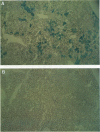Abstract
To identify DNA sequence elements from the human apolipoprotein B (apoB) gene required for high-level, correct tissue-specific expression in transgenic mice, we made several constructs that included one or more of the key regulatory elements that were previously characterized with cultured liver-derived and intestine-derived cell lines. Our data show that the apoB promoter alone (-898 to +121) is not sufficient to direct transcription in transgenic mice. An enhancer located in the second intron is absolutely required to specify transcription by the homologous apoB promoter in the livers of transgenic mice; this enhancer does not direct transcription in the small intestines. Thus, the elements controlling transcriptional activation of the apoB gene in the liver and the intestine in vivo are distinct and separable. Analysis of the DNase I hypersensitivity of the integrated human transgenes in various lines of expressing and nonexpressing mice suggests that the formation of DH4, a strong hypersensitive site in intron 2, may be a prerequisite for hepatic expression of the apoB gene. Nuclear matrix association regions (MARs) of the apoB gene may play a role in transgene expression. Constructs including MAR sequences displayed higher levels of expression than those lacking them. However, these MARs did not completely insulate the associated transgenes from position effects.
Full text
PDF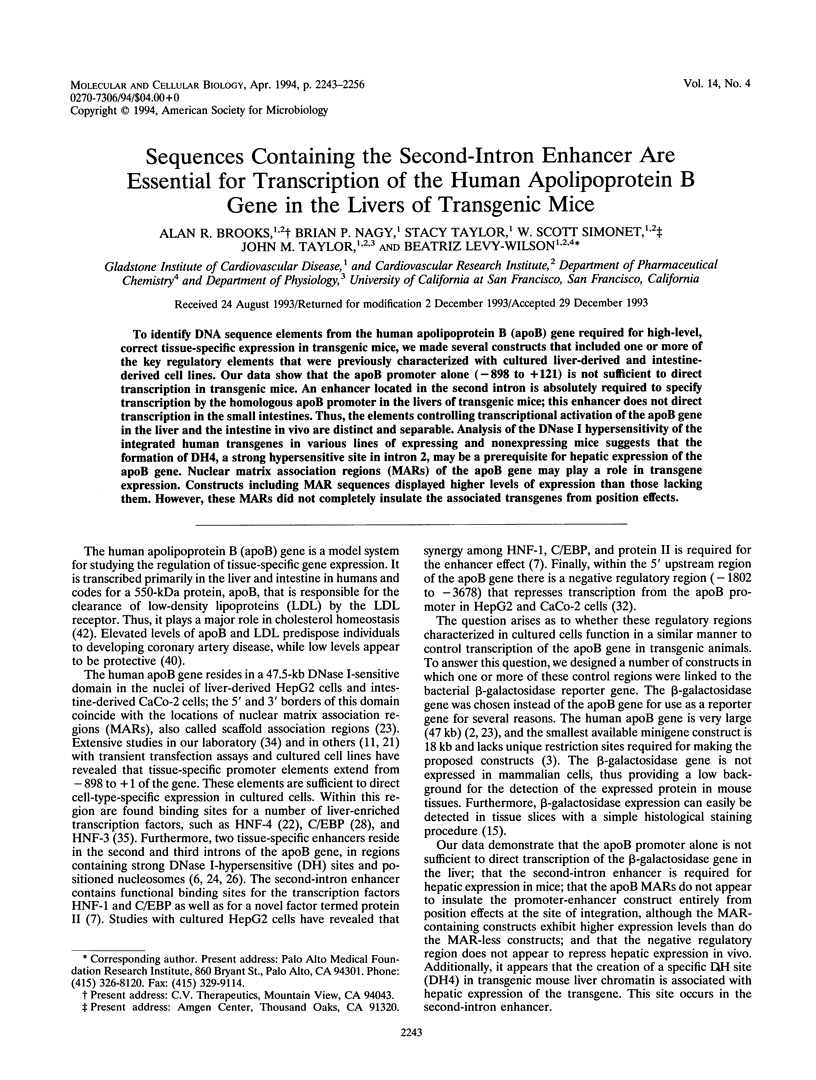
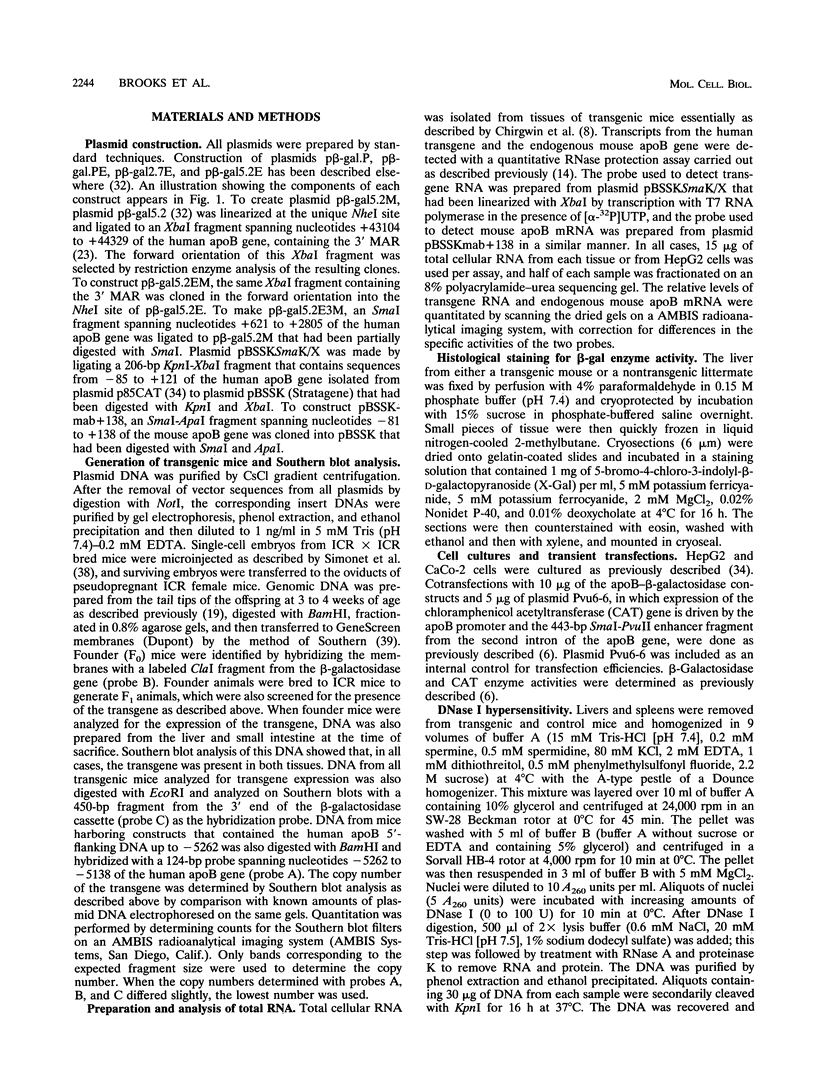

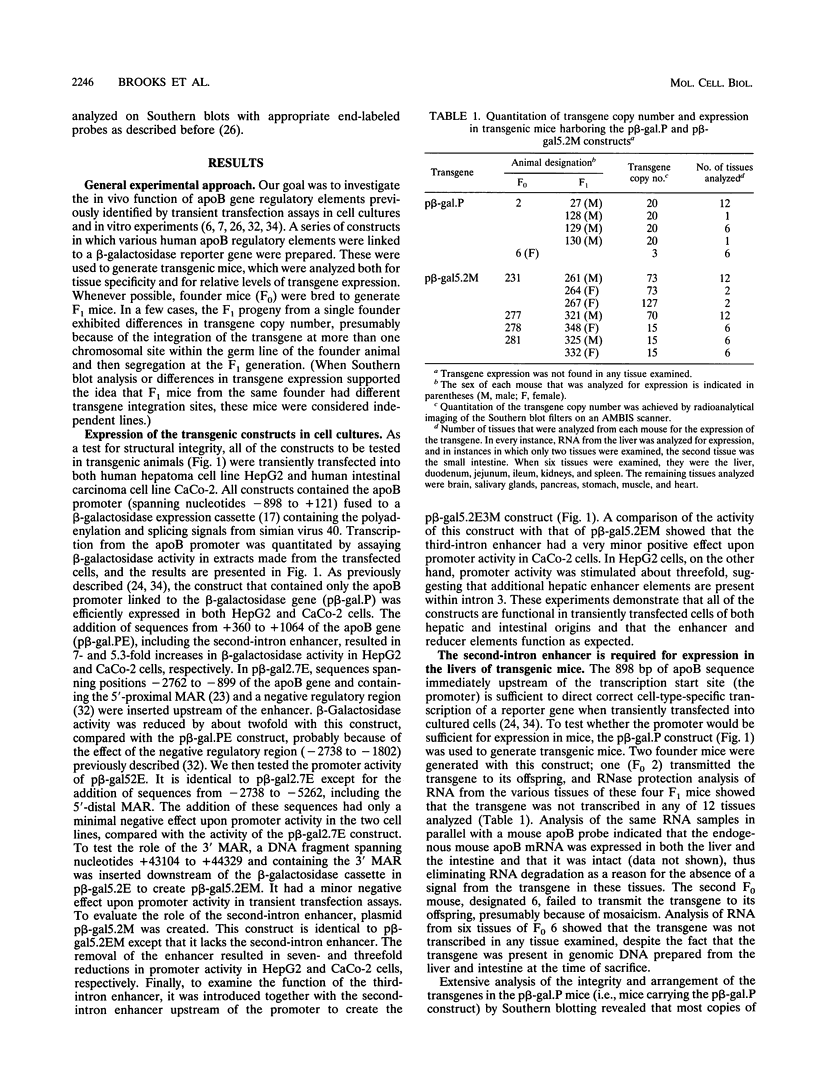
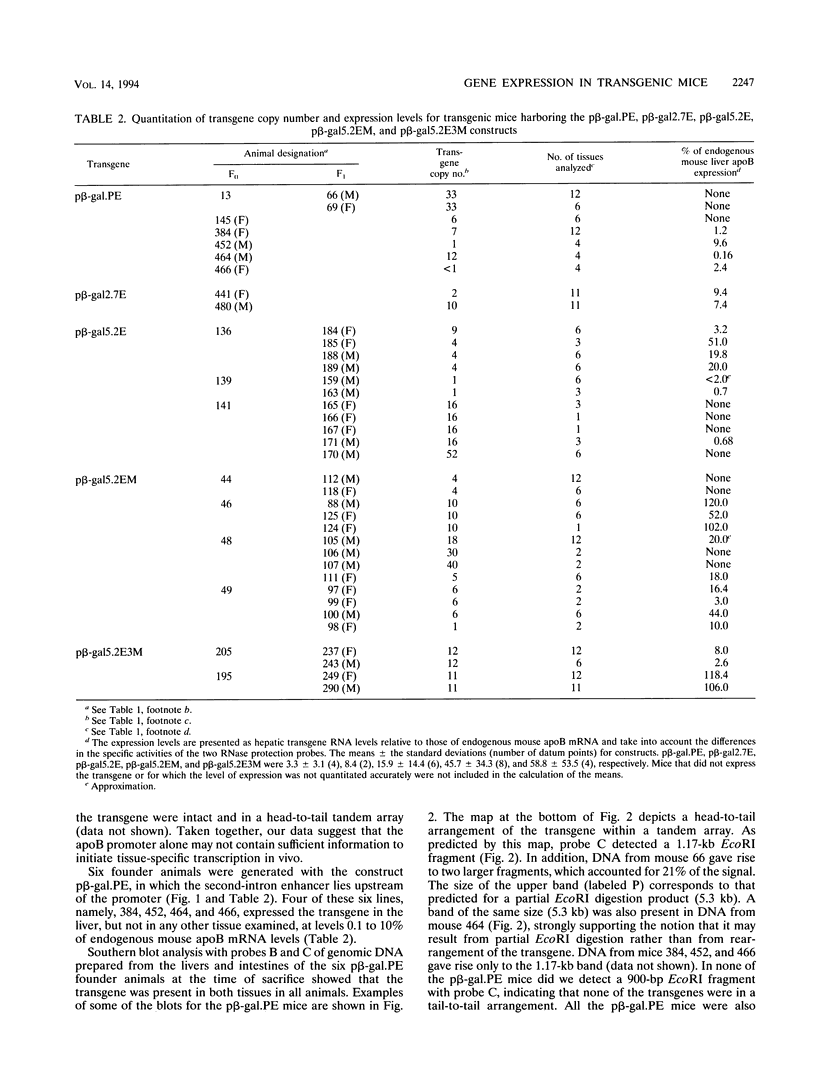

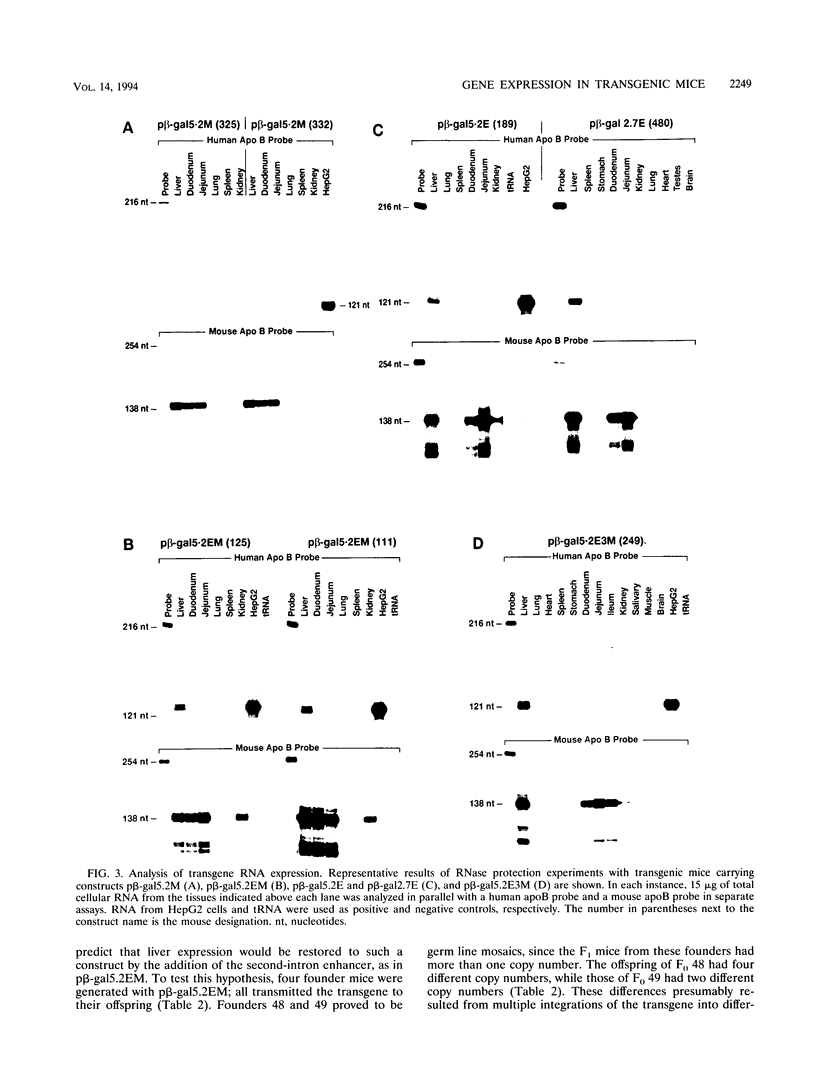
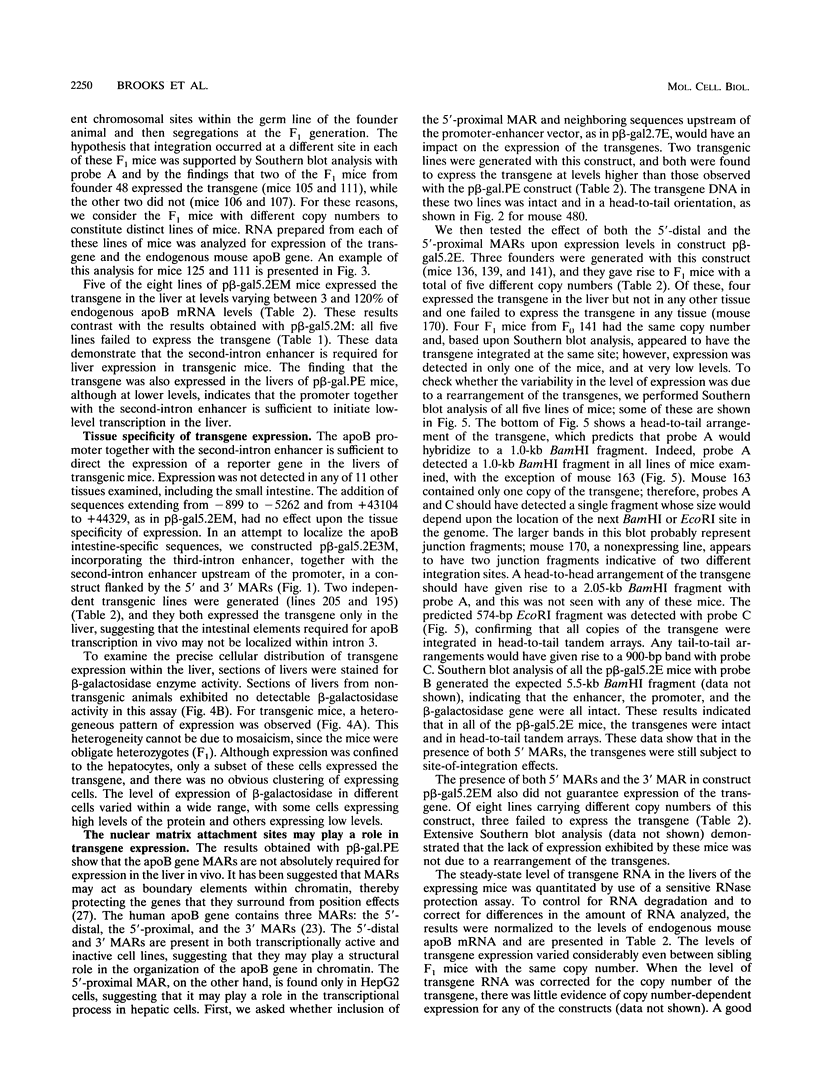

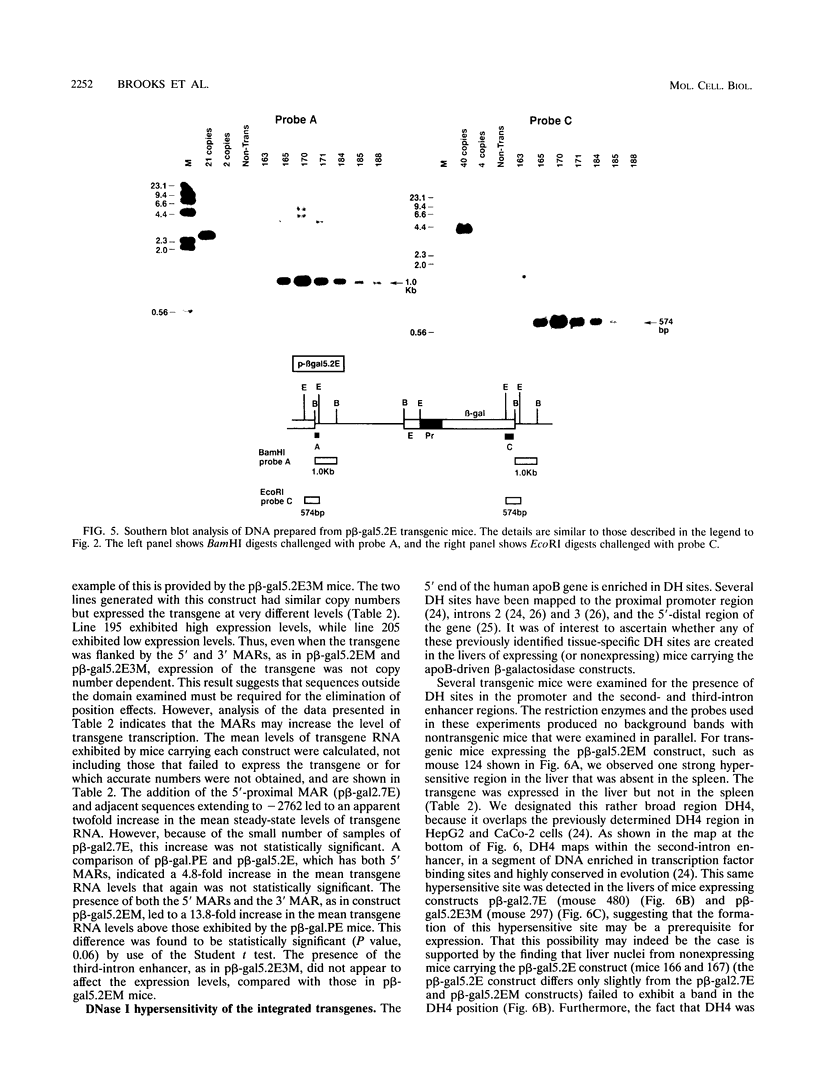
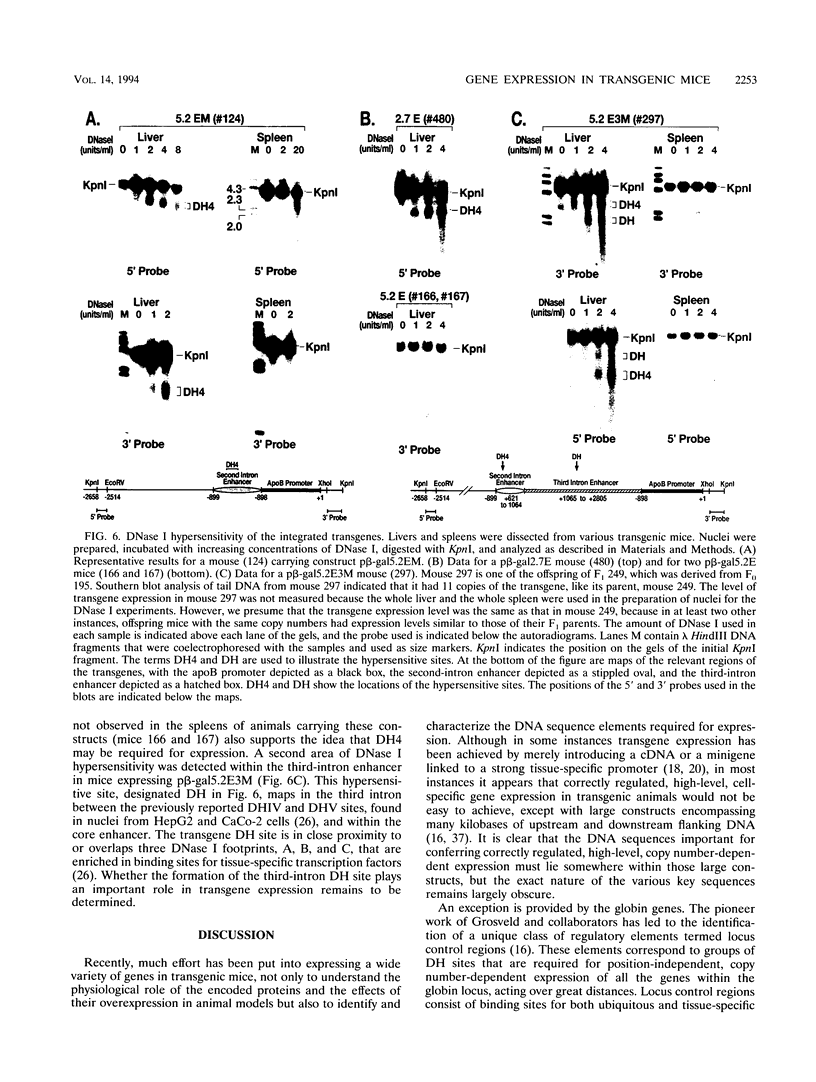
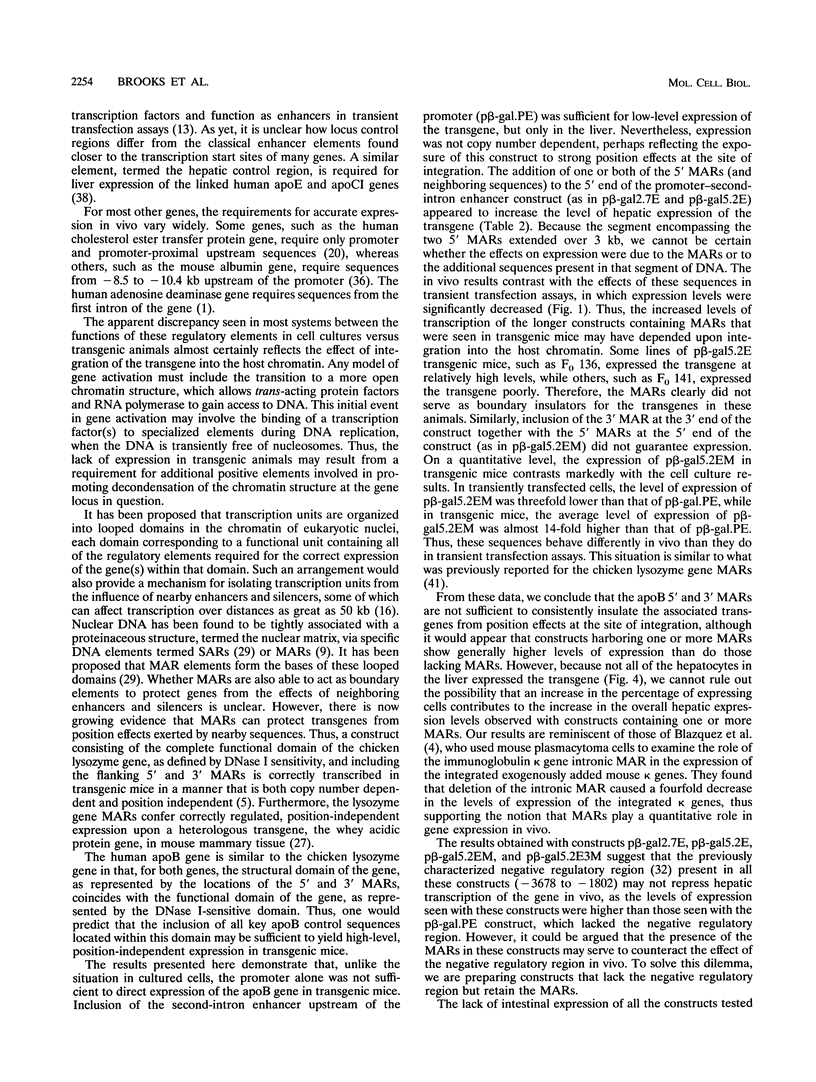
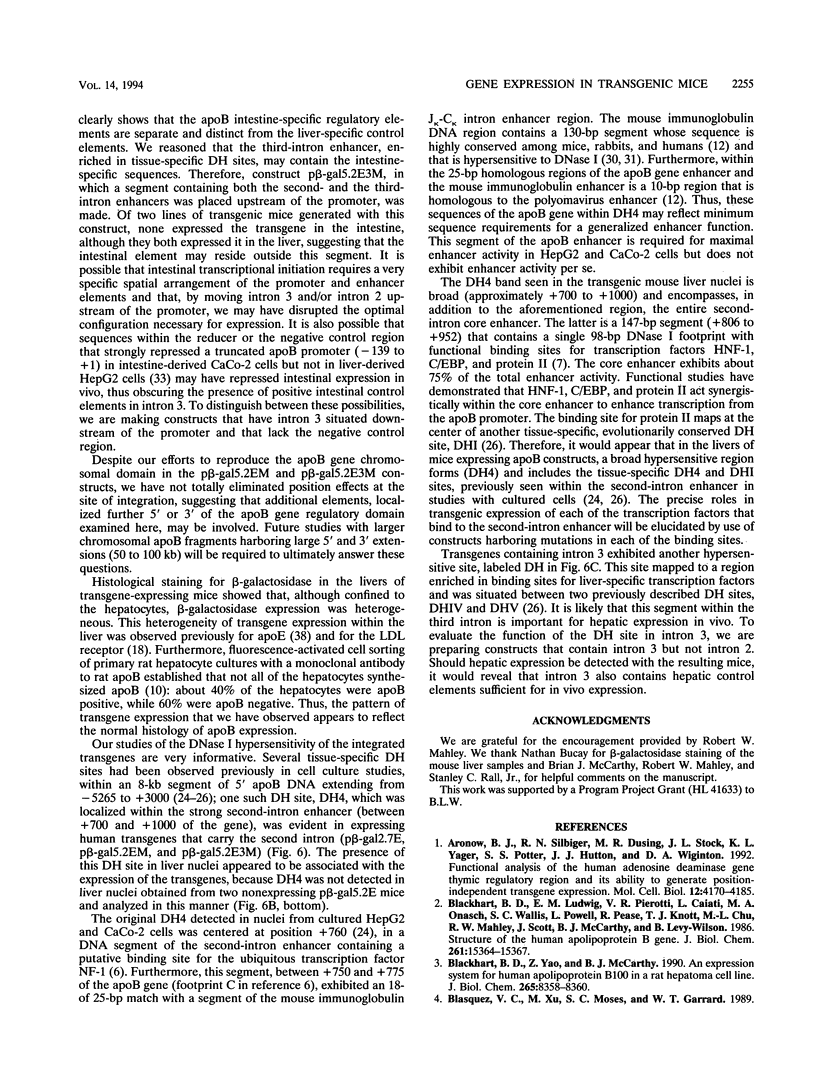
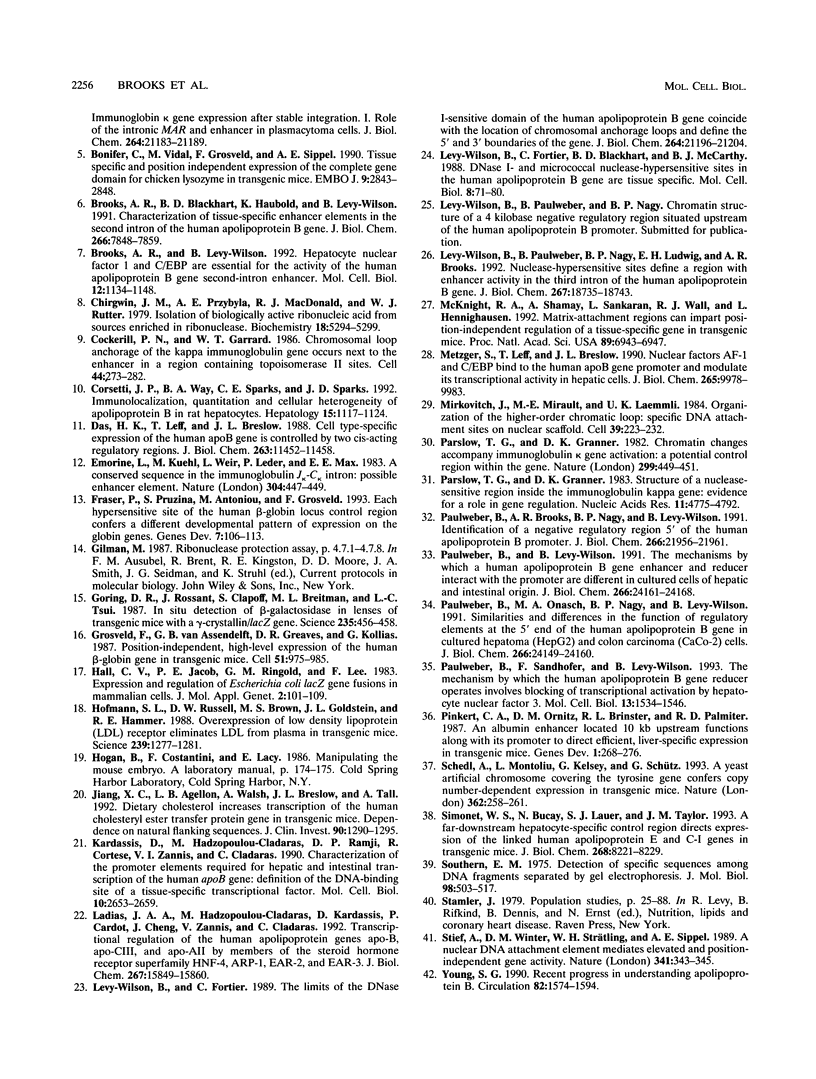
Images in this article
Selected References
These references are in PubMed. This may not be the complete list of references from this article.
- Aronow B. J., Silbiger R. N., Dusing M. R., Stock J. L., Yager K. L., Potter S. S., Hutton J. J., Wiginton D. A. Functional analysis of the human adenosine deaminase gene thymic regulatory region and its ability to generate position-independent transgene expression. Mol Cell Biol. 1992 Sep;12(9):4170–4185. doi: 10.1128/mcb.12.9.4170. [DOI] [PMC free article] [PubMed] [Google Scholar]
- Blackhart B. D., Ludwig E. M., Pierotti V. R., Caiati L., Onasch M. A., Wallis S. C., Powell L., Pease R., Knott T. J., Chu M. L. Structure of the human apolipoprotein B gene. J Biol Chem. 1986 Nov 25;261(33):15364–15367. [PubMed] [Google Scholar]
- Blackhart B. D., Yao Z. M., McCarthy B. J. An expression system for human apolipoprotein B100 in a rat hepatoma cell line. J Biol Chem. 1990 May 25;265(15):8358–8360. [PubMed] [Google Scholar]
- Bonifer C., Vidal M., Grosveld F., Sippel A. E. Tissue specific and position independent expression of the complete gene domain for chicken lysozyme in transgenic mice. EMBO J. 1990 Sep;9(9):2843–2848. doi: 10.1002/j.1460-2075.1990.tb07473.x. [DOI] [PMC free article] [PubMed] [Google Scholar]
- Brooks A. R., Blackhart B. D., Haubold K., Levy-Wilson B. Characterization of tissue-specific enhancer elements in the second intron of the human apolipoprotein B gene. J Biol Chem. 1991 Apr 25;266(12):7848–7859. [PubMed] [Google Scholar]
- Brooks A. R., Levy-Wilson B. Hepatocyte nuclear factor 1 and C/EBP are essential for the activity of the human apolipoprotein B gene second-intron enhancer. Mol Cell Biol. 1992 Mar;12(3):1134–1148. doi: 10.1128/mcb.12.3.1134. [DOI] [PMC free article] [PubMed] [Google Scholar]
- Chirgwin J. M., Przybyla A. E., MacDonald R. J., Rutter W. J. Isolation of biologically active ribonucleic acid from sources enriched in ribonuclease. Biochemistry. 1979 Nov 27;18(24):5294–5299. doi: 10.1021/bi00591a005. [DOI] [PubMed] [Google Scholar]
- Cockerill P. N., Garrard W. T. Chromosomal loop anchorage of the kappa immunoglobulin gene occurs next to the enhancer in a region containing topoisomerase II sites. Cell. 1986 Jan 31;44(2):273–282. doi: 10.1016/0092-8674(86)90761-0. [DOI] [PubMed] [Google Scholar]
- Corsetti J. P., Way B. A., Sparks C. E., Sparks J. D. Immunolocalization, quantitation and cellular heterogeneity of apolipoprotein B in rat hepatocytes. Hepatology. 1992 Jun;15(6):1117–1124. doi: 10.1002/hep.1840150624. [DOI] [PubMed] [Google Scholar]
- Das H. K., Leff T., Breslow J. L. Cell type-specific expression of the human apoB gene is controlled by two cis-acting regulatory regions. J Biol Chem. 1988 Aug 15;263(23):11452–11458. [PubMed] [Google Scholar]
- Emorine L., Kuehl M., Weir L., Leder P., Max E. E. A conserved sequence in the immunoglobulin J kappa-C kappa intron: possible enhancer element. Nature. 1983 Aug 4;304(5925):447–449. doi: 10.1038/304447a0. [DOI] [PubMed] [Google Scholar]
- Fraser P., Pruzina S., Antoniou M., Grosveld F. Each hypersensitive site of the human beta-globin locus control region confers a different developmental pattern of expression on the globin genes. Genes Dev. 1993 Jan;7(1):106–113. doi: 10.1101/gad.7.1.106. [DOI] [PubMed] [Google Scholar]
- Goring D. R., Rossant J., Clapoff S., Breitman M. L., Tsui L. C. In situ detection of beta-galactosidase in lenses of transgenic mice with a gamma-crystallin/lacZ gene. Science. 1987 Jan 23;235(4787):456–458. doi: 10.1126/science.3099390. [DOI] [PubMed] [Google Scholar]
- Grosveld F., van Assendelft G. B., Greaves D. R., Kollias G. Position-independent, high-level expression of the human beta-globin gene in transgenic mice. Cell. 1987 Dec 24;51(6):975–985. doi: 10.1016/0092-8674(87)90584-8. [DOI] [PubMed] [Google Scholar]
- Hall C. V., Jacob P. E., Ringold G. M., Lee F. Expression and regulation of Escherichia coli lacZ gene fusions in mammalian cells. J Mol Appl Genet. 1983;2(1):101–109. [PubMed] [Google Scholar]
- Hofmann S. L., Russell D. W., Brown M. S., Goldstein J. L., Hammer R. E. Overexpression of low density lipoprotein (LDL) receptor eliminates LDL from plasma in transgenic mice. Science. 1988 Mar 11;239(4845):1277–1281. doi: 10.1126/science.3344433. [DOI] [PubMed] [Google Scholar]
- Jiang X. C., Agellon L. B., Walsh A., Breslow J. L., Tall A. Dietary cholesterol increases transcription of the human cholesteryl ester transfer protein gene in transgenic mice. Dependence on natural flanking sequences. J Clin Invest. 1992 Oct;90(4):1290–1295. doi: 10.1172/JCI115993. [DOI] [PMC free article] [PubMed] [Google Scholar]
- Kardassis D., Hadzopoulou-Cladaras M., Ramji D. P., Cortese R., Zannis V. I., Cladaras C. Characterization of the promoter elements required for hepatic and intestinal transcription of the human apoB gene: definition of the DNA-binding site of a tissue-specific transcriptional factor. Mol Cell Biol. 1990 Jun;10(6):2653–2659. doi: 10.1128/mcb.10.6.2653. [DOI] [PMC free article] [PubMed] [Google Scholar]
- Ladias J. A., Hadzopoulou-Cladaras M., Kardassis D., Cardot P., Cheng J., Zannis V., Cladaras C. Transcriptional regulation of human apolipoprotein genes ApoB, ApoCIII, and ApoAII by members of the steroid hormone receptor superfamily HNF-4, ARP-1, EAR-2, and EAR-3. J Biol Chem. 1992 Aug 5;267(22):15849–15860. [PubMed] [Google Scholar]
- Levy-Wilson B., Fortier C., Blackhart B. D., McCarthy B. J. DNase I- and micrococcal nuclease-hypersensitive sites in the human apolipoprotein B gene are tissue specific. Mol Cell Biol. 1988 Jan;8(1):71–80. doi: 10.1128/mcb.8.1.71. [DOI] [PMC free article] [PubMed] [Google Scholar]
- Levy-Wilson B., Fortier C. The limits of the DNase I-sensitive domain of the human apolipoprotein B gene coincide with the locations of chromosomal anchorage loops and define the 5' and 3' boundaries of the gene. J Biol Chem. 1989 Dec 15;264(35):21196–21204. [PubMed] [Google Scholar]
- Levy-Wilson B., Paulweber B., Nagy B. P., Ludwig E. H., Brooks A. R. Nuclease-hypersensitive sites define a region with enhancer activity in the third intron of the human apolipoprotein B gene. J Biol Chem. 1992 Sep 15;267(26):18735–18743. [PubMed] [Google Scholar]
- McKnight R. A., Shamay A., Sankaran L., Wall R. J., Hennighausen L. Matrix-attachment regions can impart position-independent regulation of a tissue-specific gene in transgenic mice. Proc Natl Acad Sci U S A. 1992 Aug 1;89(15):6943–6947. doi: 10.1073/pnas.89.15.6943. [DOI] [PMC free article] [PubMed] [Google Scholar]
- Metzger S., Leff T., Breslow J. L. Nuclear factors AF-1 and C/EBP bind to the human ApoB gene promoter and modulate its transcriptional activity in hepatic cells. J Biol Chem. 1990 Jun 15;265(17):9978–9983. [PubMed] [Google Scholar]
- Mirkovitch J., Mirault M. E., Laemmli U. K. Organization of the higher-order chromatin loop: specific DNA attachment sites on nuclear scaffold. Cell. 1984 Nov;39(1):223–232. doi: 10.1016/0092-8674(84)90208-3. [DOI] [PubMed] [Google Scholar]
- Parslow T. G., Granner D. K. Chromatin changes accompany immunoglobulin kappa gene activation: a potential control region within the gene. Nature. 1982 Sep 30;299(5882):449–451. doi: 10.1038/299449a0. [DOI] [PubMed] [Google Scholar]
- Parslow T. G., Granner D. K. Structure of a nuclease-sensitive region inside the immunoglobin kappa gene: evidence for a role in gene regulation. Nucleic Acids Res. 1983 Jul 25;11(14):4775–4792. doi: 10.1093/nar/11.14.4775. [DOI] [PMC free article] [PubMed] [Google Scholar]
- Paulweber B., Brooks A. R., Nagy B. P., Levy-Wilson B. Identification of a negative regulatory region 5' of the human apolipoprotein B promoter. J Biol Chem. 1991 Nov 15;266(32):21956–21961. [PubMed] [Google Scholar]
- Paulweber B., Levy-Wilson B. The mechanisms by which a human apolipoprotein B gene enhancer and reducer interact with the promoter are different in cultured cells of hepatic and intestinal origin. J Biol Chem. 1991 Dec 15;266(35):24161–24168. [PubMed] [Google Scholar]
- Paulweber B., Onasch M. A., Nagy B. P., Levy-Wilson B. Similarities and differences in the function of regulatory elements at the 5' end of the human apolipoprotein B gene in cultured hepatoma (HepG2) and colon carcinoma (CaCo-2) cells. J Biol Chem. 1991 Dec 15;266(35):24149–24160. [PubMed] [Google Scholar]
- Paulweber B., Sandhofer F., Levy-Wilson B. The mechanism by which the human apolipoprotein B gene reducer operates involves blocking of transcriptional activation by hepatocyte nuclear factor 3. Mol Cell Biol. 1993 Mar;13(3):1534–1546. doi: 10.1128/mcb.13.3.1534. [DOI] [PMC free article] [PubMed] [Google Scholar]
- Pinkert C. A., Ornitz D. M., Brinster R. L., Palmiter R. D. An albumin enhancer located 10 kb upstream functions along with its promoter to direct efficient, liver-specific expression in transgenic mice. Genes Dev. 1987 May;1(3):268–276. doi: 10.1101/gad.1.3.268. [DOI] [PubMed] [Google Scholar]
- Schedl A., Montoliu L., Kelsey G., Schütz G. A yeast artificial chromosome covering the tyrosinase gene confers copy number-dependent expression in transgenic mice. Nature. 1993 Mar 18;362(6417):258–261. doi: 10.1038/362258a0. [DOI] [PubMed] [Google Scholar]
- Simonet W. S., Bucay N., Lauer S. J., Taylor J. M. A far-downstream hepatocyte-specific control region directs expression of the linked human apolipoprotein E and C-I genes in transgenic mice. J Biol Chem. 1993 Apr 15;268(11):8221–8229. [PubMed] [Google Scholar]
- Southern E. M. Detection of specific sequences among DNA fragments separated by gel electrophoresis. J Mol Biol. 1975 Nov 5;98(3):503–517. doi: 10.1016/s0022-2836(75)80083-0. [DOI] [PubMed] [Google Scholar]
- Stief A., Winter D. M., Strätling W. H., Sippel A. E. A nuclear DNA attachment element mediates elevated and position-independent gene activity. Nature. 1989 Sep 28;341(6240):343–345. doi: 10.1038/341343a0. [DOI] [PubMed] [Google Scholar]
- Young S. G. Recent progress in understanding apolipoprotein B. Circulation. 1990 Nov;82(5):1574–1594. doi: 10.1161/01.cir.82.5.1574. [DOI] [PubMed] [Google Scholar]





